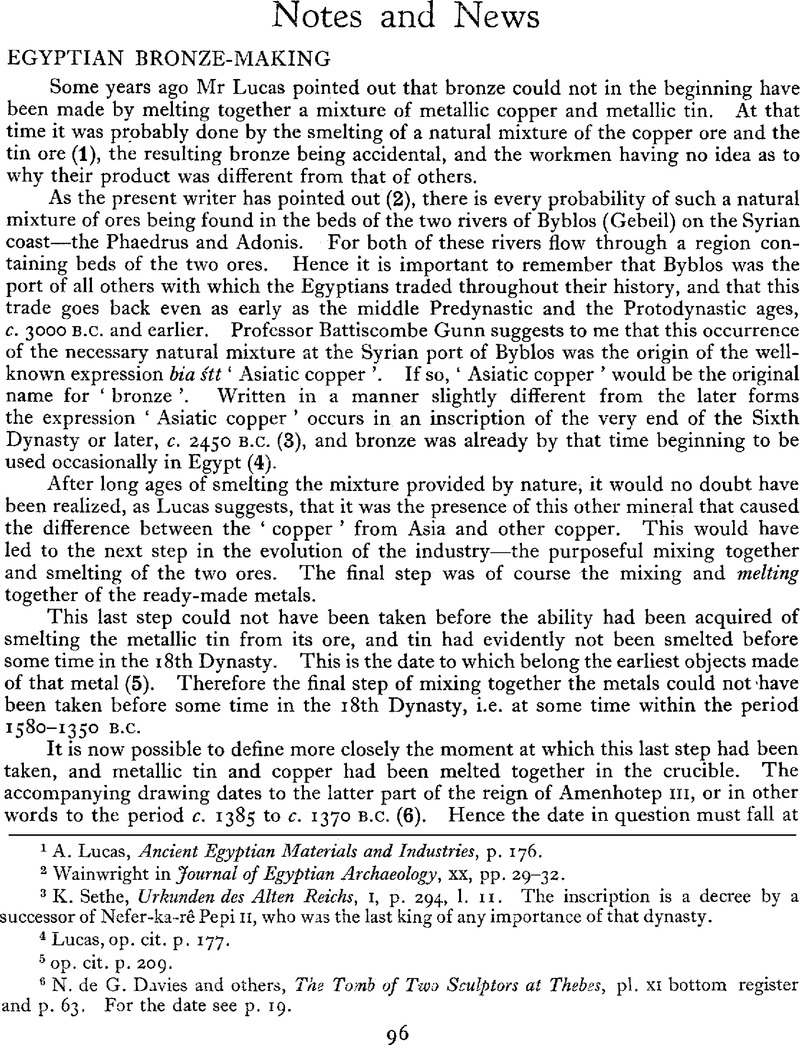Article contents
Egyptian Bronze-Making
Published online by Cambridge University Press: 02 January 2015
Abstract

- Type
- Notes and News
- Information
- Copyright
- Copyright © Antiquity Publications Ltd 1943
References
1 Lucas, A., Ancient Egyptian AFaaterials and Industries, p. 176 Google Scholar.
2 Wainwright, in Journal of Egyptian Archaeology, XX, pp. 29–32 Google Scholar.
3 Sethe, K., Urkunden des Alten Reichs, I, p. 294, l. 11Google Scholar. The inscription is a decree by a successor of Nefer-ka-rê Pepi II, who Was the last king of any importance of that dynasty.
4 Lucas, op. cit. p. 177.
5 op. cit. p. 209.
6 Divies, N. de G. and others, The Tomb of Two Sculptors at Thebes, pl. XI bottom register and p. 63 Google Scholar. For the date see p. 19.
7 Déchelette, J., Manuel d'archéologie, II, 397–490, fig. 160Google Scholar. Much of the information, but in less detail, will be found in SirEvans, A. J., The Palace of Minos II, 624, fig. 391Google Scholar; IV, 652, fig. 636, where two of the nineteen found at Hagia Triada in Crete are shown. Evans quotes others that have been found at other places in Crete and a piece of one that was found at Knossos itself. Yet others come from Sardinia, Cyprus, Mycenae, Chalkis, and other places on the mainland of Greece. His figure 637 shows how often these ingots are recorded on the tablets from Knossos. They are also brought to Egypt as tribute by the Syrians and Davies, Keftiuans, N. de G., Bull. Metrop. MS. of Art, New York, 1926,Google Scholar The Egyptian Expedition, 1924-1925, p. 48, fig. 5Google Scholar; Wreszinski, Atlas zur Altaegyptischen Kulturgeschichte, pls. 334-5; Nina de G. Davies, The Tomb of Huy, pl. XIX top register. For the red colour of Wreszinski's and Mrs Davies' examples see Wilkinson, J. G., The Manners and Customs of the Ancient Egyptians (ed. Birch), I, pls. 11 A, B, following p. 38 Google Scholar; Lepsius, Denkmäler, III, pl. 116 A. Pl. XXI of Davies' (unpublished) drawings shows that those ingots set down on the ground in Wreszinski's pl. 335, are labelled hmt ‘copper’.
8 Beginning of the 16th century A.D., Verhulpen, E., Buluba et Balubaïsés du Katanga, p. 98 Google Scholar; in the 70's of last century Cameron, V. L., Across Africa, p. 239 Google Scholar and fig. (9 or 10 were slung together, and 2 of the slings, one at each end of a pole, constituted a man's load of about 50 to 60 pounds' weight, p. 396); 20th century, Torday, and Joyce, , Notes ethnogruphiques sur des populations habitant les bassins du Kasai et du Kwango oriental, pp. 51, 52 Google Scholar. The present writer possesses one kindly procured for him from the Katanga by Sir Reginald Wingate, and also part of a much heavier one of which only the long sides are hollow. A mould for a cross-shaped ingot very like the one under discussion was found at Zimbabwe, Bent, Th., The Ruined Cities of Mashonaland (1893), p. 218 Google Scholar.
9 V. Scheil, Le tombeau des graveurs, pl. 11, bottom register (published in Méms. publiés par les membres de la miss. arch. française du Caire, II, 555–69)Google Scholar.
10 Petrie, , Arts and Crafts of Ancient Egypt, p. 103 Google Scholar.
11 Lucas, op. cit. p. 426.
- 1
- Cited by




